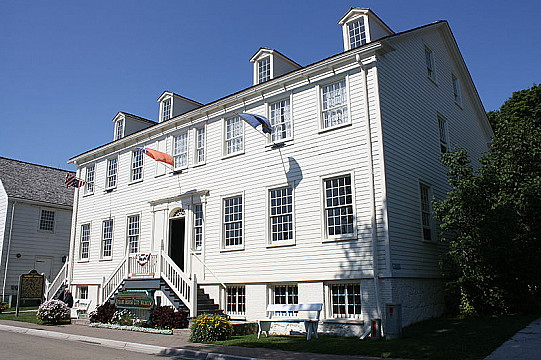Robert Stuart House
34 Market Street, Mackinac Island, Michigan
Built 1817, for the resident agent of the American Fur Company who at that time was Ramsay Crooks (1787-1859). The white frame house that is today a museum stands two-and-a-half stories high with a gabled roof and projecting dormers. Two sets of stairs lead up to the front door with sidelights and pilasters either side. The large rooms with their fireplaces and the graceful stairway are reminiscent of the Colonial mansions found in New England. Along with furniture from the period, there are a great many relics on display from the early fur trading days.

In 1808, John Jacob Astor (1763-1848) established the American Fur Company. In 1810, a young Scotsman, Robert Stuart (1785-1848), accompanied the expedition Astor sent to Oregon to establish a fur trading post - Astoria - on the Columbia River. In 1811, Stuart was chosen to carry dispatches back to his employer in New York and the dangerous and arduous journey undertaken by him was later eloquently described in Astoria (1836) by Washington Irving (1783-1859).
In 1817, Stuart was sent to Mackinac Island to assist Ramsay Crooks (1787-1859), then General Manager of the American Fur Company and the first occupant of the house. In 1820, he succeeded Crooks and just two years later saw the company clear more than $3 million of furs. Stuart remained in the house with his wife, Elizabeth Emma Sullivan (1792-1866) and their eight eldest children until 1835. Owing to his prominent role on the island and within the fur trade his semi-official residence has been named for him.
In the years leading up to the Civil War, the island became a popular summer resort and the old Agent's home became a boarding house. Visitors included Edward Everett Hale (1822-1909), who - inspired by a newspaper article while staying there - went on to write The Man Without a Country. Another visitor was Constance Fenimore Woolson (1840-1894), a grandniece of James Fenimore Cooper (1789-1851), whose novel Anne (1882) is a romantic story of the island during the Civil War.
In 1871, the house and it's adjoining outbuildings were purchased by James Franklin Cable (1826-1891) and interlinked with palisades to form the John Jacob Astor Hotel - the center of island society until the construction of the Grand Hotel in 1887. In 1900, it was sold to the City of Mackinac Island, remaining as an hotel until 1929. In 1941, the buildings were once again separated and the old house has since served as a museum.
Categories
Styles
Share
Connections
Be the first to connect to this house. Connect to record your link to this house. or just to show you love it! Connect to Robert Stuart House →
